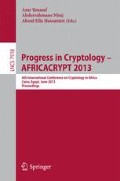Abstract
In the context of secure content distribution, the content is encrypted and then broadcasted in a public channel, each legitimate user is provided a decoder and a secret key for decrypting the received signals. One of the main threat for such a system is that the decoder can be cloned and then sold out with the pirate secret keys. Traitor tracing allows the authority to identify the malicious users (are then called traitors) who successfully collude to build pirate decoders and pirate secret keys. This primitive is introduced by Chor, Fiat and Naor in ’94 and a breakthrough in construction is given by Boneh and Franklin at Crypto ’99 in which they consider three models of traitor tracing: non-black-box tracing model, single-key black box tracing model, and general black box tracing model.
Beside the most important open problem of obtimizing the black-box tracing, Boneh-Franklin also left an open problem concerning non-black-box tracing, by mentioning: “it seems reasonable to believe that there exists an efficient public key traitor tracing scheme that is completely collusion resistant. In such a scheme, any number of private keys cannot be combined to form a new key. Similarly, the complexity of encryption and decryption is independent of the size of the coalition under the pirate’s control. An efficient construction for such a scheme will provide a useful solution to the public key traitor tracing problem”.
As far as we know, this problem is still open. In this paper, we resolve this question in the affirmative way, by constructing a very efficient scheme with all parameters are of constant size and in which the full collusion of traitors cannot produce a new key. Our proposed scheme is moreover dynamic.
Access this chapter
Tax calculation will be finalised at checkout
Purchases are for personal use only
Preview
Unable to display preview. Download preview PDF.
References
Agrawal, S., Dodis, Y., Vaikuntanathan, V., Wichs, D.: On continual leakage of discrete log representations. Cryptology ePrint Archive, Report 2012/367 (2012), http://eprint.iacr.org/2012/367
Billet, O., Phan, D.H.: Efficient Traitor Tracing from Collusion Secure Codes. In: Safavi-Naini, R. (ed.) ICITS 2008. LNCS, vol. 5155, pp. 171–182. Springer, Heidelberg (2008)
Billet, O., Phan, D.H.: Traitors collaborating in public: Pirates 2.0. In: Joux, A. (ed.) EUROCRYPT 2009. LNCS, vol. 5479, pp. 189–205. Springer, Heidelberg (2009)
Boneh, D., Boyen, X.: Short signatures without random oracles. In: Cachin, C., Camenisch, J.L. (eds.) EUROCRYPT 2004. LNCS, vol. 3027, pp. 56–73. Springer, Heidelberg (2004)
Boneh, D., Boyen, X., Goh, E.-J.: Hierarchical identity based encryption with constant size ciphertext. In: Cramer, R. (ed.) EUROCRYPT 2005. LNCS, vol. 3494, pp. 440–456. Springer, Heidelberg (2005)
Boneh, D., Franklin, M.K.: An efficient public key traitor scheme (Extended abstract). In: Wiener, M. (ed.) CRYPTO 1999. LNCS, vol. 1666, pp. 338–353. Springer, Heidelberg (1999)
Boneh, D., Gentry, C., Waters, B.: Collusion resistant broadcast encryption with short ciphertexts and private keys. In: Shoup, V. (ed.) CRYPTO 2005. LNCS, vol. 3621, pp. 258–275. Springer, Heidelberg (2005)
Boneh, D., Naor, M.: Traitor tracing with constant size ciphertext. In: Ning, P., Syverson, P.F., Jha, S. (eds.) ACM CCS 2008, pp. 501–510. ACM Press (October 2008)
Boneh, D., Sahai, A., Waters, B.: Fully collusion resistant traitor tracing with short ciphertexts and private keys. In: Vaudenay, S. (ed.) EUROCRYPT 2006. LNCS, vol. 4004, pp. 573–592. Springer, Heidelberg (2006)
Boneh, D., Waters, B.: A fully collusion resistant broadcast, trace, and revoke system. In: Juels, A., Wright, R.N., Vimercati, S. (eds.) ACM CCS 2006, pp. 211–220. ACM Press (October/ November 2006)
Boyen, X.: Mesh signatures. In: Naor, M. (ed.) EUROCRYPT 2007. LNCS, vol. 4515, pp. 210–227. Springer, Heidelberg (2007)
Chor, B., Fiat, A., Naor, M.: Tracing traitors. In: Desmedt, Y.G. (ed.) CRYPTO 1994. LNCS, vol. 839, pp. 257–270. Springer, Heidelberg (1994)
Delerablée, C., Paillier, P., Pointcheval, D.: Fully collusion secure dynamic broadcast encryption with constant-size ciphertexts or decryption keys. In: Takagi, T., Okamoto, T., Okamoto, E., Okamoto, T. (eds.) Pairing 2007. LNCS, vol. 4575, pp. 39–59. Springer, Heidelberg (2007)
Junod, P., Karlov, A., Lenstra, A.K.: Improving the boneh-franklin traitor tracing scheme. In: Jarecki, S., Tsudik, G. (eds.) PKC 2009. LNCS, vol. 5443, pp. 88–104. Springer, Heidelberg (2009)
Kiayias, A., Yung, M.: Traitor tracing with constant transmission rate. In: Knudsen, L.R. (ed.) EUROCRYPT 2002. LNCS, vol. 2332, pp. 450–465. Springer, Heidelberg (2002)
Naor, M., Pinkas, B.: Efficient trace and revoke schemes. In: Frankel, Y. (ed.) FC 2000. LNCS, vol. 1962, pp. 1–20. Springer, Heidelberg (2001)
Nuida, K.: A general conversion method of fingerprint codes to (More) robust fingerprint codes against bit erasure. In: Kurosawa, K. (ed.) ICITS 2009. LNCS, vol. 5973, pp. 194–212. Springer, Heidelberg (2010)
Guillot, P., Nimour, A., Phan, D.H., Trinh, V.C.: Optimal Public Key Traitor Tracing Scheme in Non-Black Box Model. Full version available at, http://www.di.ens.fr/users/phan/2013-africa-a.pdf
Tonien, D., Safavi-Naini, R.: An efficient single-key pirates tracing scheme using cover-free families. In: Zhou, J., Yung, M., Bao, F. (eds.) ACNS 2006. LNCS, vol. 3989, pp. 82–97. Springer, Heidelberg (2006)
Author information
Authors and Affiliations
Editor information
Editors and Affiliations
Rights and permissions
Copyright information
© 2013 Springer-Verlag Berlin Heidelberg
About this paper
Cite this paper
Guillot, P., Nimour, A., Phan, D.H., Trinh, V.C. (2013). Optimal Public Key Traitor Tracing Scheme in Non-Black Box Model. In: Youssef, A., Nitaj, A., Hassanien, A.E. (eds) Progress in Cryptology – AFRICACRYPT 2013. AFRICACRYPT 2013. Lecture Notes in Computer Science, vol 7918. Springer, Berlin, Heidelberg. https://doi.org/10.1007/978-3-642-38553-7_8
Download citation
DOI: https://doi.org/10.1007/978-3-642-38553-7_8
Publisher Name: Springer, Berlin, Heidelberg
Print ISBN: 978-3-642-38552-0
Online ISBN: 978-3-642-38553-7
eBook Packages: Computer ScienceComputer Science (R0)

